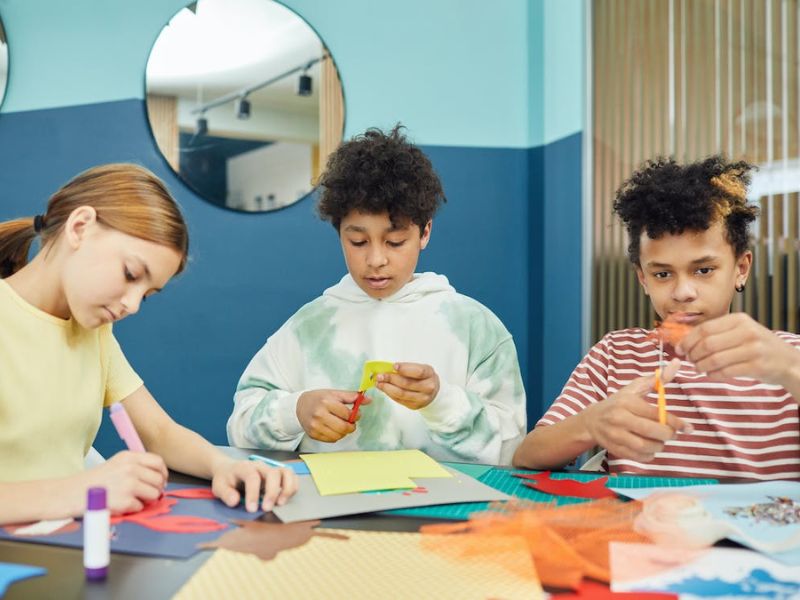Middle school is a crucial period, when nurturing creativity is as important as teaching traditional academic subjects. During this time, kids undergo many changes as they grow into teenagers. In this transformative period, they start to form their unique identities and are highly receptive to new ideas and experiences. With this in mind, educators should try to create an environment that not only acknowledges but celebrates creative thinking.
Teachers should offer learners opportunities for creative expression so that they learn to think outside the box, solve problems innovatively, and express themselves as their personalities form. Here are nine effective strategies for educators to foster creativity in the classroom.

9 Ways to Help Students Be More Creative
1. Integrate creative activities across subjects
Creativity should not be confined to art or music class. Teachers can integrate creative activities across all subjects – and you can go here to see some examples of versatile exercises. For instance, in a history class, students could reenact historical events, or in science, they could design experiments to solve real-world problems. These activities allow students to apply what they have learned in a hands-on, imaginative way.
2. Create a safe and supportive environment
The foundation of encouraging creativity is establishing a classroom environment where students feel safe to express their ideas without fear of judgment or failure. Teachers should foster an atmosphere of acceptance and encouragement, where all ideas are valued. Celebrating diverse perspectives and teaching students to give and receive constructive feedback respectfully can significantly boost their confidence to share creative thoughts.
3. Encourage curiosity and questioning
Curiosity is the fuel of creativity. Teachers should encourage students to ask questions and explore topics that interest them. This could be facilitated through open-ended questions, brainstorming sessions, or independent research projects. By nurturing curiosity, students are motivated to delve deeper and think creatively about subjects.
4. Utilize technology and multimedia
In today’s digital age, technology can be a powerful tool for creative expression. Utilizing multimedia presentations, digital art tools, and interactive learning platforms can engage students in a way that traditional methods may not. For instance, students could create a podcast discussing a book they read in English class or use video editing software to produce a documentary on a social studies topic.
5. Provide choice and autonomy
Giving students some degree of choice in their learning can significantly enhance their creativity. This could be as simple as allowing them to choose the topic of a project or the medium through which they present their work. When students have a say in their learning process, they are more engaged and motivated to be creative.

6. Implement collaborative projects
Collaboration can spark creativity as students are exposed to different perspectives and ideas. Group projects encourage students to brainstorm and build on each other’s ideas. Teachers can facilitate collaborative activities that require creative problem-solving and collective decision-making.
7. Incorporate art and music
Art and music are direct conduits to creativity. These subjects allow students to express themselves in non-verbal ways and explore different mediums and styles. Even if a school has limited resources for art and music education, teachers can integrate these elements into other subjects. For example, writing and performing a song about a scientific concept or creating visual art inspired by a literary piece.
8. Encourage reflective thinking
Reflective thinking is a critical aspect of the creative process. Teachers should encourage students to reflect on their learning experiences, the choices they made during a project, and what they might do differently next time. This reflection helps learners understand their creative process and develop their creative skills further.
9. Celebrate creative successes
Recognizing and celebrating creative efforts, regardless of the outcome, is essential. This could be through a classroom display of student work, a performance, or a showcase event. Celebrations of creativity reinforce the value of creative thinking and encourage students to continue to express themselves.
Conclusion
In fostering creativity, educators help students develop a skill set that includes innovative problem-solving, critical thinking, and the confidence to express their unique perspectives. By implementing these strategies, educators can create a classroom environment that nurtures the creative spirits of middle school students. Creativity is a critical skill for success in the 21st century, and by encouraging it in the classroom, teachers are preparing students not just for school, but for life.
Also read: Urgent need for teacher-parent collaboration

























